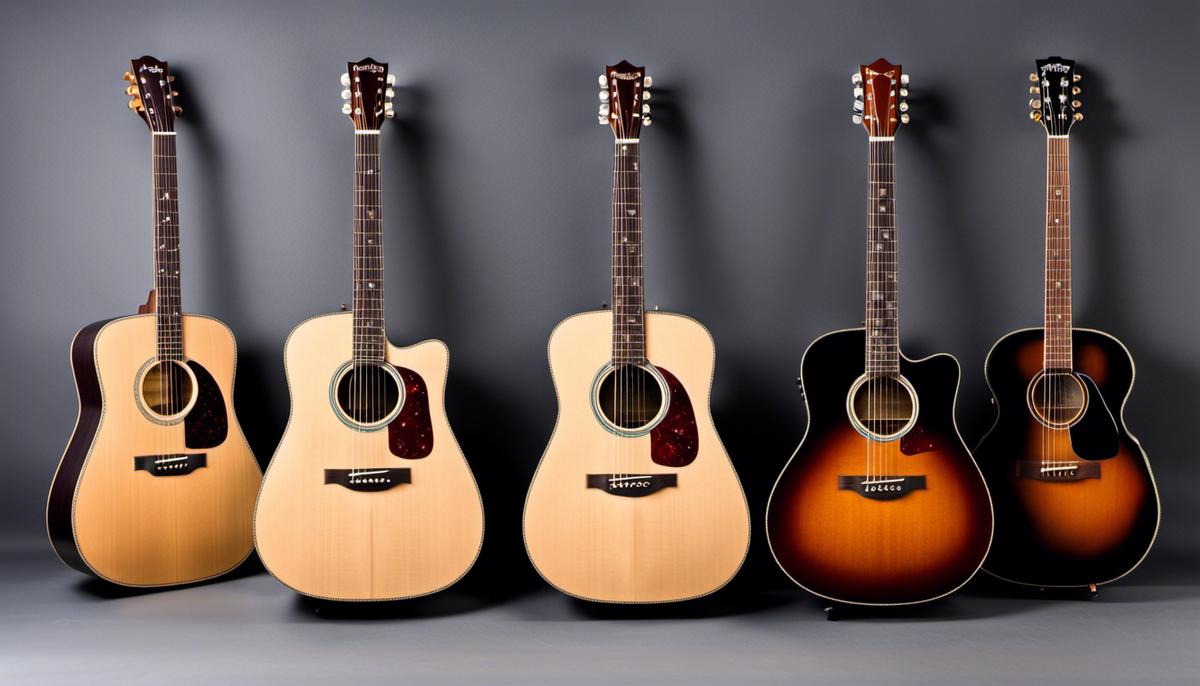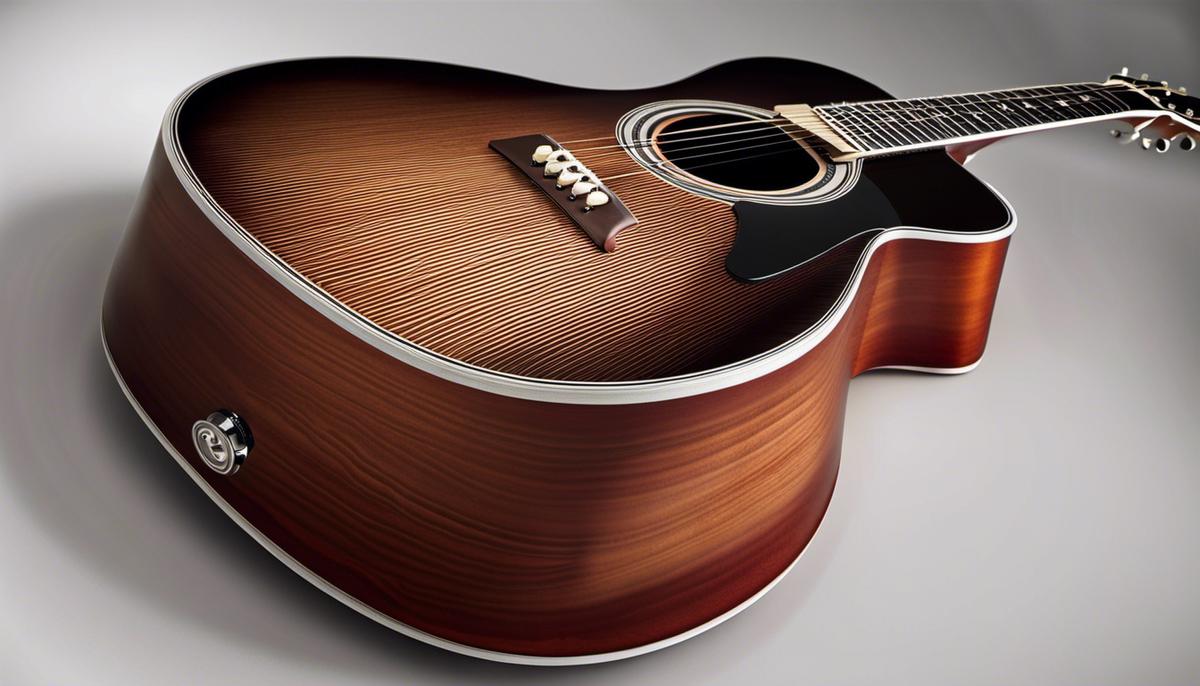
For the uninitiated, acquiring an acoustic guitar can be a daunting task. With a plethora of styles, designs, and price ranges available in the market, making an informed decision requires a thorough understanding of guitars. This guide aims to demystify the process by delving into different types of acoustic guitars, their features, and how they cater to various musical needs. Moreover, we’ll explore factors to consider when purchasing your instrument, alongside insights on price range, esteemed brands, and tips on ensuring optimum aesthetic and structural quality of your acoustic guitar. This comprehensive guide seeks to arm potential guitar buyers with the necessary knowledge to make a wise investment in their musical journey.
Understanding Different Types of Acoustic Guitars
Understanding Different Types of Acoustic Guitars
The world of acoustic guitars is diverse, with different types tailored to a variety of musical genres and player preferences. One of the first distinctions to understand is between classical and steel-string guitars.
Classical Guitars
Classical guitars utilize nylon strings, yielding a softer, warmer sound – perfect for the intricate flourishes of flamenco or the measured cadences of classical music. The top, back, and sides of a classical guitar are typically made of high-quality wood such as cedar or spruce, which contribute to a rich, resonant tone. The wider neck and flat fingerboard are designed for complex fingerpicking techniques. Remember, though, nylon strings are less loud and robust than their steel counterparts.
Steel-String Acoustic Guitars
On the other hand, steel-string acoustic guitars produce a brighter, louder sound, well-suited to a wide range of music from rock and pop to folk and country. They typically have a narrower neck, which could be more comfortable for some players, especially for strumming or picking. The tough steel strings can be hard on beginners’ fingers, but they produce a loud, clear, and punchy sound that many music styles favor.
Types within Steel-String Category
Within the steel-string category, there are further subtypes. Dreadnought guitars, for instance, are robust, large-bodied instruments known for their powerful sound and are often favorite choices among bluegrass and rock players. Auditorium and grand concert guitars, meanwhile, have a smaller, more manageable size with a balanced, versatile tone, appealing to fingerstyle players.
Parlor guitars are even smaller and comfortable to hold, often with a midrange-focused sound. They’re widely liked for their convenience, easy playability, and unique vintage tone. Jumbo guitars, conversely, are known for their large size and powerful, expansive sound, excellent for performers who need to fill up space with their guitar’s volume and tone.
Archtop Guitars
Then there are the archtop guitars – they have an arched top and back rather than a flat top. These guitars, typically equipped with steel strings, produce a clear, resonant tone which is suitable for many forms of music but is particularly associated with jazz.
Experience the Richness of Twelve-String Guitars
Introducing the twelve-string guitars, designed with the foundation of a standard acoustic but enhanced with six additional strings. This exquisite design is paired in six pairs, known as courses. The extra strings catalyze additional vibrations which results in a noticeably fuller, more rich sound compared to the standard six-string guitars.

Photo by claritycontrol on Unsplash
Factors to Consider When Buying an Acoustic Guitar
Body Style: Exploring its Influence on Sound and Playability
Moving on to the body style of an acoustic guitar, this is undoubtedly the foremost consideration for perspective buyers. The body style holds significant influence over the sound quality and the overall comfort level of the instrument. It’s essential to recognize that larger models such as dreadnought and jumbo styles often produce a louder, more resonant sound. On the other hand, smaller body styles, including concert and grand concert, offer a balanced tone and are more comfortable – particularly for smaller individuals. It’s worth noting, a folk-style body is designed to accommodate fingerstyle playing, while a dreadnought is adapted for bold, strum-heavy sounds.
Wood Type: The Heart of Tone Differences
The type of wood a guitar is made from heavily impacts the tones it can produce. There are different types of woods for the top, back, and sides of an acoustic guitar. The top wood, also known as the soundboard, significantly influences the guitar’s sound. Spruce is the most common top wood, known for its bright sound and excellent projection. Mahogany, on the other hand, is often used for back and sides and produces a warmer sound.
Neck Material and Design: Comfort and Playability
Your preferred style of music and your hand size can dictate the most suitable neck width and shape for your hands. For example, wider necks can accommodate complex fingerstyle playing, while slimmer necks provide an easy grip for chord strumming. The material of the neck is typically mahogany or maple, where the former is usually lighter and the latter adds stiffness and stability to the neck.
Fretboard Material: Impact on Feel and Tone
Common choices for fretboard material include rosewood and maple. Rosewood is popular due to its soft feel and the warm tonality it adds to the guitar’s sound. Maple, on the other hand, offers a slicker feel and adds a brighter tone. A well-crafted fretboard should have smoothly finished frets to provide a comfortable and fast playing experience.
Types of Strings: Steel vs. Nylon
Your choice of strings is primarily influenced by the music you prefer to play. Steel strings are most common, typically used for country, rock, bluegrass, and pop music. They create a louder, brighter tone. In contrast, nylon strings, often used for classical and flamenco music, are softer on the fingers and provide a softer, mellower tone.
Assessing Acoustic Guitar’s Build Quality
Crucial to the purchase of an acoustic guitar is evaluating its build quality. Traditional construction techniques that have been tried and tested often result in a guitar that not only sounds superior but also stands the test of time. Look out for characteristics of good craftsmanship such as evenly applied finishes, perfect fitting joints, and frets that have been smoothly filed. Navidating these elements positively contributes to the lifespan and sound of your guitar. Ultimately, a well-built guitar is an investment that will give you pleasure for many years.

Price Ranges and Brands
Understanding Acoustic Guitar Price Points
Acoustic guitars are available at a variety of price points, designed to suit varying budgets. You can find instruments ranging from basic, entry-level guitars to luxurious, high-end models. The price can be as affordable as under a $100 to upwards of several thousands of dollars. Let’s delve a bit deeper into these pricing categories.
Entry-Level Guitars (Under $200)
Typically, entry-level acoustic guitars cost below $200. These guitars, while not boasting the quality of higher-end models, still provide a viable option for beginners. Brands such as Yamaha, Rogue, and Fender offer reliable models in this range. Among these, Yamaha’s FG800 has often been highlighted for its excellent value.
Mid-Range Guitars ($200 – $800)
This category is considered the sweet spot for amateurs and intermediate players. In this range, you get a significant leap in terms of sound quality and craftsmanship. Brands like Epiphone, Ibanez, and Gretsch dominate this segment. The Epiphone Hummingbird PRO and the Ibanez AW54CE are popular choices for their high-quality tonewoods and impressive sound.
High-End Guitars ($800 and Above)
Acoustic guitars at this price level are often targeted towards professional musicians or serious enthusiasts. Brands like Martin, Taylor, and Gibson are highly respected in this price range. These guitars are crafted from premium materials, and they feature meticulous detailing for superior sound quality and playing experience. Examples include Martin D-28, Taylor 814ce, and Gibson J-45.
Prominent Guitar Brands
You should also factor the reputation of guitar brands into your decision. Different brands have distinctive characteristics and specialize in certain areas, so understanding these nuances can help you find the most suitable guitar.
Yamaha
Yamaha is a well-known brand offering guitars at an affordable price point without compromising quality. Their guitars are easy to play, making them ideal for beginners.
Fender
Fender offers a broad spectrum of guitars catering to different price ranges, from beginners to professionals. They are particularly known for their quality construction and the warm, vibrant tones their guitars produce.
Martin
Martin is a legendary brand in the world of acoustic guitars. Famous for their dreadnought guitars, their instruments are favored for their rich, deep tones and impeccable build quality. They cater largely to the high-end market, so their guitars are generally found in the $800 and above range.
Taylor
Taylor is one of the most innovative guitar brands, often incorporating proprietary technology in their models. Their guitars are well-made, have excellent playability, and produce bright, crisp tones. Like Martin, Taylor’s guitars generally cater to the high-end market.
Considerations
Choosing the ideal acoustic guitar is highly personal and should revolve around your own unique playing style and musical taste. Don’t hesitate to explore a variety of models, brands, and price ranges to discover the one that truly clicks with you in terms of feel and sound.

Where to Buy And Ensuring Aesthetic and Structural Quality
Purchasing Venues
There are plenty of places to buy acoustic guitars, both in physical stores and online. Buying from a local guitar shop enables you to interact with the instrument personally, giving an authentic feel for its playability and sound quality. Prominent music stores like Sam Ash and Guitar Center offer a broad array of brands, catering to all levels, from beginners to professionals.
On the other hand, purchasing online provides a wider selection and added convenience. Reliable online platforms such as Amazon, Sweetwater, and Musician’s Friend offer an extensive assortment of acoustic guitars. You can also explore online marketplaces like eBay and Reverb for new as well as used guitars.
Inspecting Acoustic Guitars Before Purchase
Whether buying online or offline, several factors are key in determining the aesthetic and structural quality of a guitar. First, inspect the guitar’s body for any cracks or warping, especially along the seams and edges. The surface should be smooth, with no rippling or bulging.
Next, look at the neck of the guitar. It should be straight, without any significant curves. This could affect the ease of play. Also, check the action (the distance between the strings and fretboard). If it’s too high, it could be difficult to play, and if it’s too low, the strings may buzz.
Examine the frets to ensure they are level and well-seated, with no jagged edges. The tuners should turn smoothly without resistance. Finally, look at the aesthetic aspects. Check the finish for any flaws or inconsistencies and make sure you like the general appearance of the instrument as well.
Trying Out Different Guitars Before Making a Purchase
Choosing an acoustic guitar can be subjective and often comes down to personal preference. Trying different guitars before making a purchase is essential. This allows you to hear the tone, feel the playability, and gauge the overall comfort and appeal of the instrument. Experiment with various brands, styles, shapes, and sizes until you find one that ‘feels right’. A specific guitar may have great reviews online but might not fit your personal playing style or body shape.
Hiring a Professional to Set Up the Guitar
After buying an acoustic guitar, consider hiring a professional to set it up. While guitars typically come ‘factory set’, a customized setup can make a significant difference to playability, sound, and comfort. A professional luthier or guitar technician will adjust the action to your preference, ensure the neck is straight, fix any fret issues, and generally fine-tune the instrument for optimum performance. Some stores might offer this service for free or at a discounted price upon purchase, but it can also be done independently.

With a well-informed perspective, potential buyers can navigate the market of acoustic guitars more efficiently, finding an instrument that perfectly matches their sound and feel preferences as well as their budget constrains. The complexity and diversity of this instrument makes the process of selection more refined than a simple transaction. It’s indeed an exciting journey crossing the nexus of craftsmanship, heritage, personal taste, and music. By observing the elements described in this guide, from understanding diverse guitar types, to recognizing the importance of craftsmanship and materials, you are better equipped to make a confident purchase. Here’s to the beautiful music you’re set to create with your new guitar!
Comments are closed.